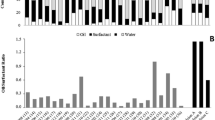Abstract
Purpose. To investigate the influence of excess surfactant on transport kinetics in emulsions, using phenylazoaniline (PAA), benzocaine, benzoic acid and phenol as model drugs. Mineral oil was chosen as the oil phase and the nonionic surfactant, polyoxyethylene oleyl ether (Brij 97) as the emulsifier.
Methods. Model drug transport in emulsions was investigated using side by side diffusion cells mounted with hydrophilic dialysis or hydrophobic membranes. A novel method, involving a combination of a membrane equilibrium technique and surface tension measurement (Wilhelmy plate method), was developed to determine surfactant critical micelle concentration (CMC) in the presence of O/W emulsions. Emulsion stability was determined by droplet size analysis as a function of time, temperature and dilution using photon correlation spectroscopy and a light blockage technique. Model drug mineral oil/water partition coefficients and aqueous solubilities were determined in the presence of surfactant.
Results. The emulsion CMC value was used to calculate micellar phase concentration. The transport rates of PAA and benzocaine in emulsions increased with increase in Brij 97 micellar concentration up to 1.0 % w/v and then decreased at higher surfactant concentrations. The transport rates of the more hydrophilic compounds, benzoic acid (ionized form, pH 7.0) and phenol, were not affected by the presence of micellar phase.
Conclusions. Excess surfactant affected the transport rates of the model drugs in the emulsions depending on drug lipophilicity. Transport rates measured using side by side diffusion cells appeared to be governed by model drug partitioning rates from the oil to the continuous phases and by membrane type.
Similar content being viewed by others
REFERENCES
E. K. Garrett. Stability of oil-in-water emulsions. J. Pharm. Sci. 54(11):1557–1570 (1965).
J. Courthaudon and J. Dickinson. Competitive adsorption of lecithin and beta-casein in O/W emulsion. J. Agric. Food Chem., 39:1365–1368 (1991).
S. E. Friberg and C. Solans. Surfactant association structures and the stability of emulsions and foams. Langmuir 2(2):121–126 (1986).
S. S. Davis, J. Hadgraft, and K. J. Palin. Medical and pharmaceutical applications of emulsions. In P. Becher (ed.), Encyclopedia of Emulsion Technology, Vol. 2, Dekker, New York, 1985, pp. 159–225.
H. Goldberg, W. I. Higuchi, N. F. H. Ho, and G. Zografi. Mechanisms of interface transport I. Theoretical considerations of diffusion and interfacial barriers in transport of solubilized systems. J. Pharm. Sci. 56(11):1432–1437 (1967).
A. Ghanem, W. I. Higuchi, and A. P. Simonelli. Interfacial barriers in interphase transport: Retardation of the transport of diethylphthalate across the hexadecane-water interface by an adsorbed gelatin film. J. Pharm. Sci. 58(2):165–174 (1969).
A. Ghanem, W. I. Higuchi, and A. P. Simonelli. Interfacial barriers in interphase transport II: Influence of additives upon the transport of diethylphthalate across the hexadecane-gelatin-water interface. J. Pharm. Sci. 59(2):232–237 (1970).
A. Ghanem, W. I. Higuchi, and A. P. Simonelli. Interfacial barriers in interphase transport II: Transport of cholesterol and other organic solutes into hexadecane-gelatin-water matrices. J. Pharm. Sci. 59(5):659–665 (1970).
R. T. Lostritto, L. Goei, and S. L. Silvestri. Theoretical considerations of drug release from submicron oil in water emulsions. J. Par. Sci. Tech. 41(6):214–219 (1987).
Y. Levy and S. Benita. Drug release from submicronized O/W emulsion. a new in vitro kinetic evaluation model. Int. J. Pharm. 66:29–37 (1990).
P. C. Hiemenz. Principles of colloid and surface chemistry, Marcel Dekker, New York, 1986, 291.
D. J. Burgess and J. K. Yoon. Influence of interfacial properties on perfluorocarbon/aqueous emulsion stability. Colloids Surf. in press (1995).
G. E. Amidon, W. I. Higuchi, and N. F. H. Ho. Theoretical and experimental studies of transport of micelle-solubilized solutes. J. Pharm. Sci. 71(1):77–84 (1982).
S. J. Candau, F. Merikhi, G. Waton, and P. Lemarechal. Temperature-jump study of elongated micelles of cetyltrimethylammonium bromide. J. Phys. France 51:977–989 (1990).
Author information
Authors and Affiliations
Rights and permissions
About this article
Cite this article
Yoon, K.A., Burgess, D.J. Effect of Nonionic Surfactant on Transport of Model Drugs in Emulsions. Pharm Res 13, 433–439 (1996). https://doi.org/10.1023/A:1016052811789
Issue Date:
DOI: https://doi.org/10.1023/A:1016052811789




